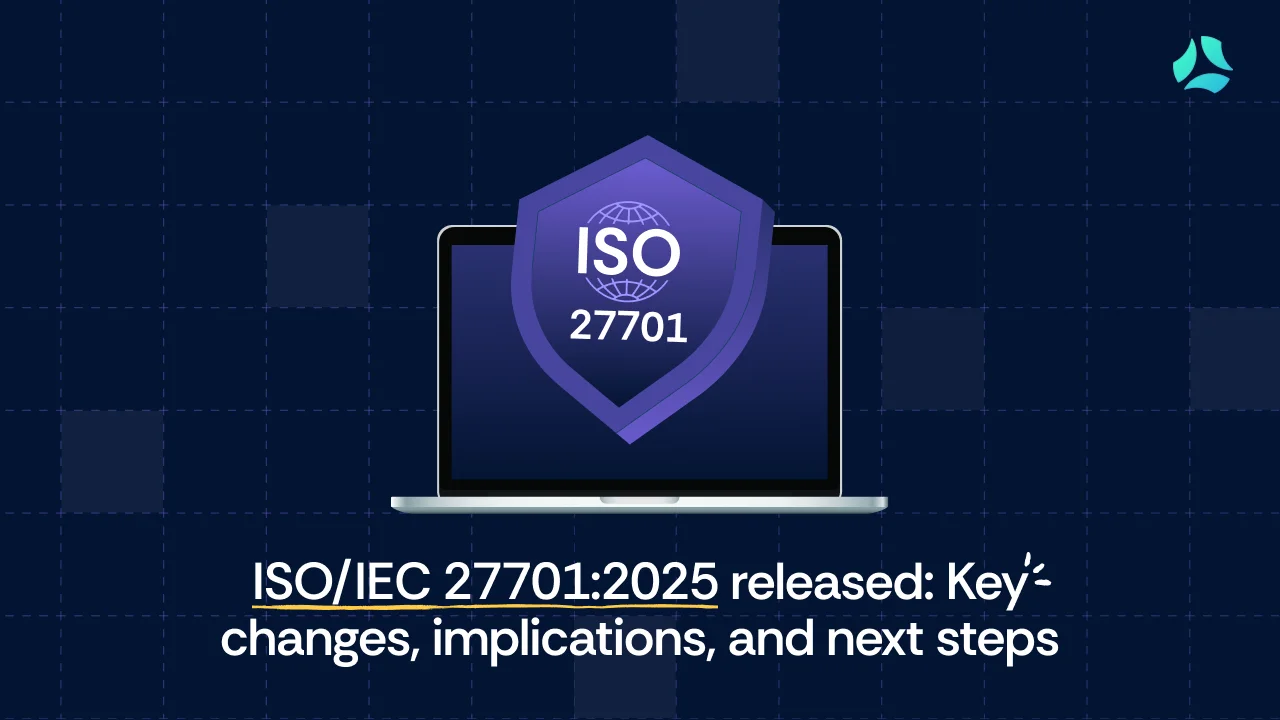Best Compliance Audit Software in 2025: Top 7 Tools for Compliance

As compliance requirements get more complex and audit cycles become more frequent, security teams are under pressure to stay ahead of these changing regulatory demands.
This leads to greater audit requirements and more resource-intensive preparation efforts, which consume valuable time and increase the risk of audit fatigue and costly compliance failures.
However, most compliance and security leaders still rely on scattered spreadsheets, email chains, and last-minute scrambles to prepare for audits.
A 2024 survey revealed that 32% of businesses incurred audit-related financial liabilities of over $1 million, while 31% required over 10 operatives to accomplish audit tasks. That’s time and money lost—not just once a year, but every time an audit rolls around.
Fortunately, an efficient solution exists to tackle this problem: Compliance Audit Management Software.
These tools help you:
- Automate evidence collection and control testing.
- Monitor your compliance posture in real-time.
- Streamline audit workflows across frameworks like SOC 2, ISO 27001, HIPAA, and PCI DSS.
- Get audit-ready faster, with fewer manual tasks and greater confidence.
This guide breaks down the seven best compliance audit platforms in 2025, based on usability, automation depth, integration capabilities, and scalability.
If you’re evaluating your options, start here.
Best compliance audit software in 2025: An overview
Top 7 compliance audit software: Our best picks for 2025
1. Scrut Automation
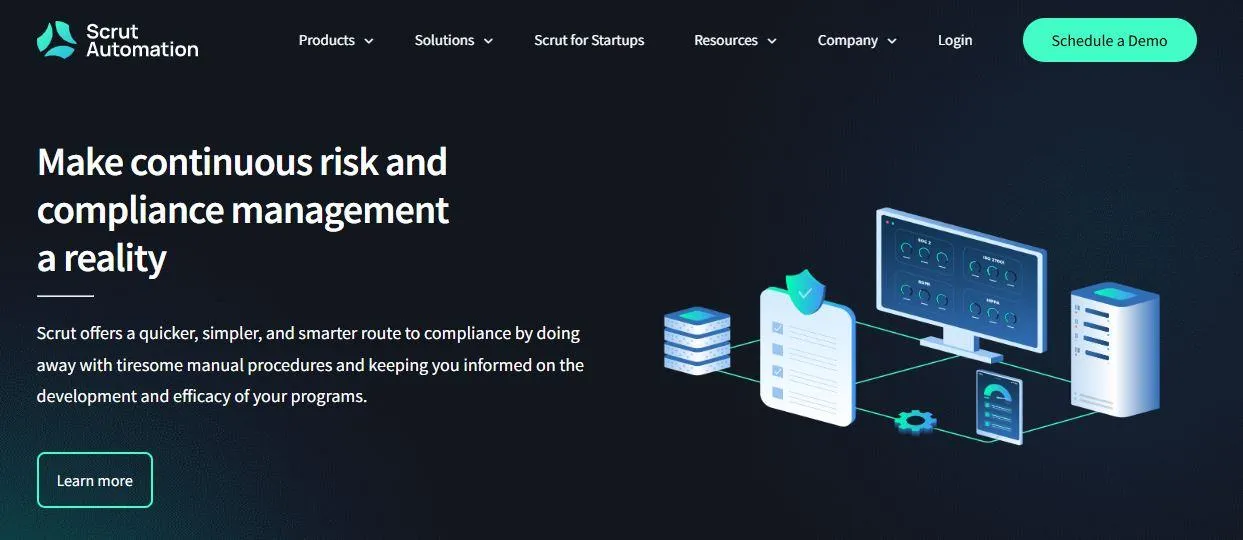
Scrut Automation, a leading compliance audit management software, offers an end-to-end compliance automation platform. With integrated risk management capabilities, it is designed to streamline regulatory compliance and audit preparation, ensuring your business becomes audit-ready in just weeks.
Scrut provides a unified governance, risk, and compliance (GRC) management platform to simplify compliance and accelerate audit readiness for businesses of all sizes, from early-stage startups and mid-market companies to large enterprises.
Let’s look at Scrut’s key features that differentiate it from other platforms.
Key features and benefits
1. Audit logs:
Keep a detailed record of a wide range of user and system activities through audit logs. Document every ongoing process, including user actions, policy updates, evidence changes, risk management tasks, system events, and more. For each recorded event, the audit log captures essential details, such as timestamp, user IDs, action performed, asset affected, and details of the changes.
This feature makes it easier for auditors to verify controls, track changes, and confirm adherence without manual data collection and review, saving your audit team’s time and effort in demonstrating compliance.
- Continuous controls monitoring: Scrut automatically runs daily control tests across your cloud infrastructure and internal systems, benchmarking against 230+ CIS standards. Integrated directly into your tech stack, it monitors control effectiveness in real time, flags gaps or misconfigurations, and assigns remediation tasks with automated alerts. The centralized dashboard offers detailed visibility into every control, helping you track risk status, validate control health, and maintain continuous audit readiness.
- Automated evidence collection with integrations: Integrate Scrut platform with over 100+ top business applications, such as cloud platforms, identity providers, HR tools, and more, to automatically collect and map audit evidence across multiple frameworks. This helps you reduce compliance efforts by more than 70% and become audit-ready without spending too much time on resources.It flags missing evidence, assigns remediation tasks, and links everything to control tests in real time.
- Audit management module: Streamline the audit process and reduce fatigue with Scrut’s Audit Center. Access framework-specific checklists for audit-readiness, track audit progress, and get a control-level compliance overview. With a centralized audit dashboard, you can efficiently collaborate with auditors, track requests and findings, and create risks and corrective actions. With automated audit report generation tailored to specific frameworks, Scrut helps share the right information with the right stakeholders fast.
- Multi-framework support: Adapt your compliance program to meet evolving business needs with Scrut’s support for 50+ compliance frameworks, including region and industry-specific standards. New frameworks are regularly added, with support for adding custom frameworks right on the platform, ensuring your business stays compliant without added complexity. With Scrut, you can eliminate redundant tasks, streamline operations, and stay competitive in new markets — all while maintaining compliance.
- Integrated risk management module: Align compliance with InfoSec risks with Scrut’s robust risk management module. With its intuitive risk register, you can create risk entries with customizable scores, choose a risk treatment strategy, and create and assign mitigation tasks with auto-alerts, ensuring nothing goes undetected. Keep detailed trail logs of risk mitigation workflows for constant audit readiness. Additionally, you can get real-time insights into your organization’s high-risk areas and compliance status with a unified risk and compliance dashboard that provides drill-down metrics, visual charts, and a jobs-to-be-done view.
In addition to platform automation, Scrut provides access to InfoSec experts who support your compliance program, guide audit execution, and help you meet framework-specific requirements—at no additional cost.
Here’s how the CEO of Orca shared their experience with the Scrut platform:

Pros
- Reduces audit preparation time by more than 70% via automation.
- Includes pre-built, auditor-vetted policy templates and framework checklists.
- Offers access to all modules–no feature-based pricing walls.
- Includes hands-on expert support and compliance program guidance.
- Trusted by 1300+ top companies globally for GRC and compliance audits.
Cons
- Complements, but doesn’t replace, your entire security stack. Scrut is best used alongside your existing security-only tools.
Pricing
Scrut offers the best custom pricing to serve businesses of all sizes. Contact the team to obtain a quote or schedule a demo.
2. LogicGate
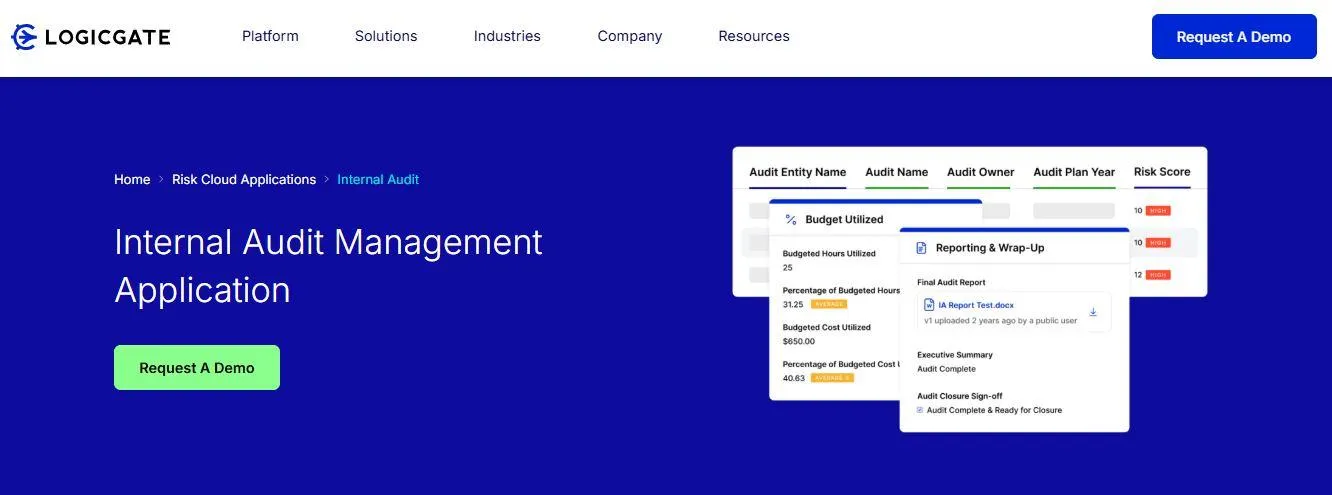
LogicGate’s Risk Cloud is a GRC platform that grows with your evolving business needs and compliance requirements. It provides a comprehensive set of applications that streamline compliance and risk management to make your business audit-ready.
Key features
- Internal audit management: Simplify your audit processes with pre-built workflows to record your company’s compliance controls, risks, logs, and findings, all in a centralized dashboard to accelerate audit success.
- Automated control testing: Integrate internal control verification and risk assessment with your compliance audit program, and automatically assign control tests, evidence requests, audit findings, and remediation workflows.
- Audit reporting: Gain enhanced visibility, streamline communication with stakeholders, and clear your next audit successfully with auto-generated audit reports.
Pros
Provides a highly customizable platform to meet businesses’ specific requirements.
Cons
The product is still under development, leading to several missing features.
Pricing
Businesses can pay for GRC applications and Power User licenses separately, with paywalls for add-on features and services. For custom pricing, contact their team.
3. Archer IRM
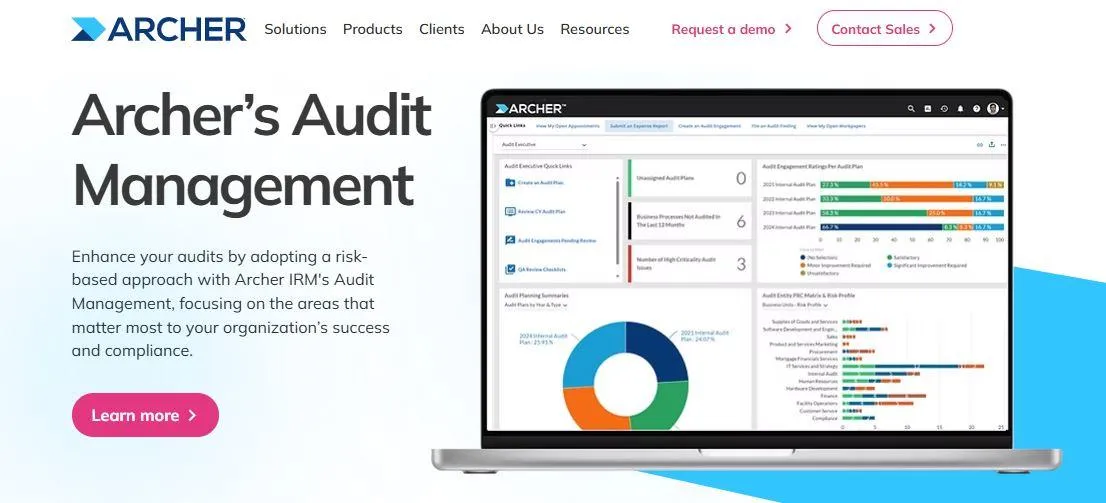
Archer IRM’s compliance audit management software offers a risk-based strategy and enables you to combine all audit activities within a single platform. With Archer, you can efficiently manage your compliance program and become audit-ready.
Key features
- Issues management: Effectively handle issues identified by your compliance, risk, and audit management teams with its integrated risk management program.
- Audit planning: Implement a risk-based audit plan customized to your organization’s requirements and prioritize mitigating the most critical risks. Keep board-level members up to date on the latest audit status and optimize resource utilization.
- Audit engagement: Leverage Archer’s audit engagement module to speed up the audit process with automated findings report generation and effective remediation workflows.
Pros
Enables a proactive approach to tackling operational threats within the organization.
Cons
Offers limited report generation capabilities and customizable features.
Pricing
Contact their sales team for custom pricing of their compliance audit software solutions.
4. Sprinto
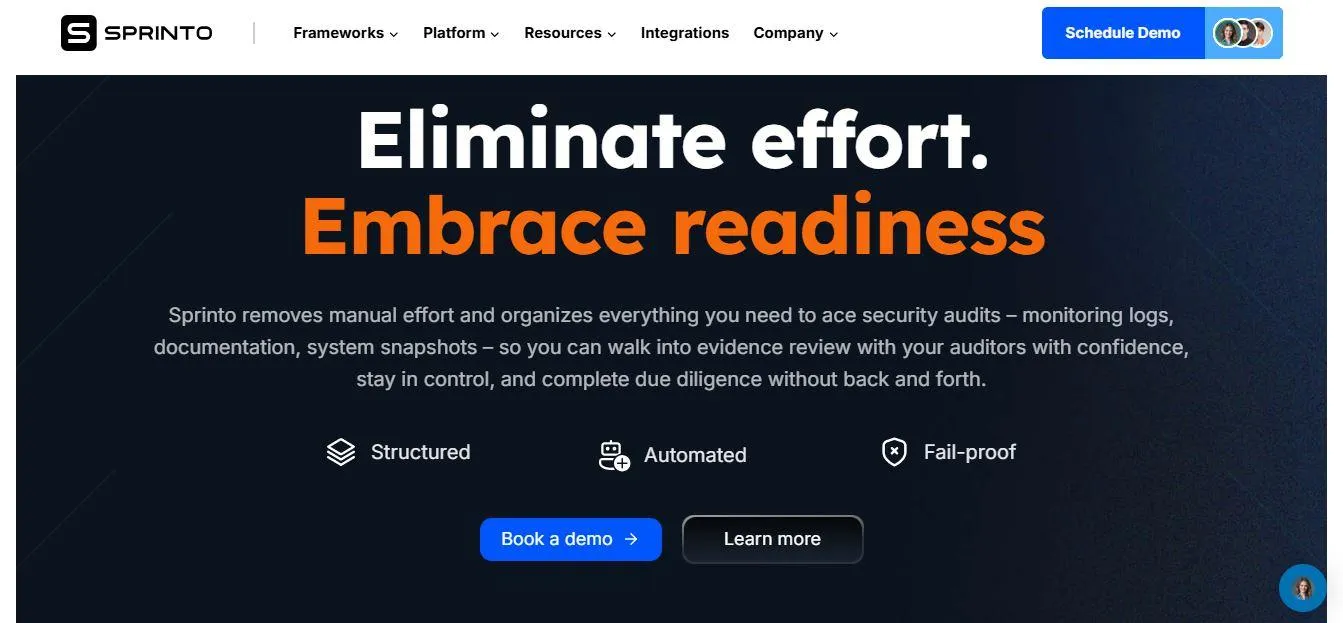
Sprinto offers compliance audit management software that helps your business automate key processes and streamline audit preparation activities. It enables the strategic organization of everything audit-related with improved resource utilization.
Key features
- Security management: Integrate cloud and other applications to identify security and compliance gaps, and automate mitigation workflows to quickly become audit-ready.
- Audit management: Automatically collect evidence with improved accuracy and document everything for audit inspections. Record compliance activities within a predefined monitoring duration and handle multiple simultaneous audits efficiently.
- Collaboration dashboard: Streamline evidence scrutiny by sharing audit assets with auditors, providing requested documents or audit trails, and tracking audit status, all within a centralized audit and compliance dashboard.
Pros
Offers user-friendly interface, easy-to-deploy integrations, and responsive customer support.
Cons
Requires improvement in customization options and provision for regular updates through email.
Pricing
Contact their team to book a demo and request a pricing quote.
5. Hyperproof
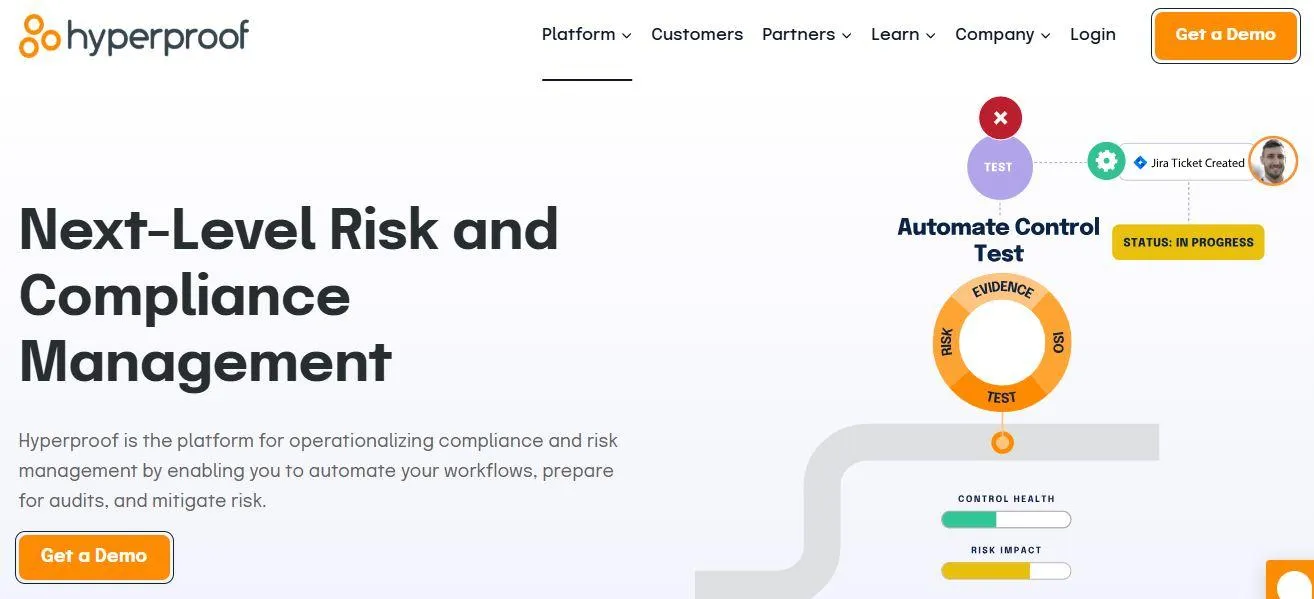
Hyperproof offers excellent audit management capabilities in its compliance management platform. It leverages automation to gather evidence and provides a centralized space to manage audit-related activities.
Key features
- Controls integration: Automatically link controls and related evidence to audit needs, simplifying audit preparation and reducing time to become audit-ready.
- Collaboration tools: Use its exclusive audit space to share audit entities with auditors, facilitating smooth collaboration and providing access to audit-specific resources.
- Audit tracker: Monitor and manage pending audit evidence requests, stay informed of audit status, and review progress on its central audit dashboard.
Pros
Provides an easy-to-implement solution with a sleek UI and multi-framework support.
Cons
Lacks important customization options for certain features and reporting needs.
Pricing
Contact their sales team directly to request a demo and get custom pricing.
6. Drata

Drata’s compliance automation platform continuously monitors your organization’s security controls and automatically gathers evidence, with the added advantage of end-to-end, streamlined workflows that help you become audit-ready quickly and efficiently.
Key features
- Audit hub: Gain access to a centralized evidence repository that enables instant document sharing with auditors, all from one place.
- Automated workflows: Automate evidence collection to accelerate the audit process and gain clear visibility into the auditor’s requests and pending items through a centralized dashboard.
Pros
Provides outstanding customer support with live chats and a 24/7 chatbot.
Cons
Requires a steep learning curve to get familiar with the platform.
Pricing
Contact their sales team to schedule a demo and request a custom pricing quote.
7. AuditBoard

AuditBoard is user-friendly compliance and audit management software that offers customizable features and streamlined processes, resulting in improved efficiency in risk, compliance, sustainability, and audit management.
Key features
- Automated audit workflows: Reduce manual efforts and enhance productivity with automated key processes, including audit planning, implementation, testing, remediation, and reporting.
- Centralized dashboard: Manage every auditable entity, such as risks, evidence, and compliance issues, from a central audit hub with visualization tools for real-time audit and compliance status visibility.
- Integrations: Simplify and scale your risk, audit, and compliance programs by integrating the platform with your existing tools across various categories, including CRM, HRIS, accounting, identity and access management, and more.
Pros
Provides an intuitive UI and excellent expert support from across the globe.
Cons
Requires more customization options and is more expensive compared to other platforms.
Pricing
Request a demo and custom pricing quotes through their company’s website.
Key features to look for in compliance audit software
Preparing for an audit is rarely straightforward. When managed manually, this process is not only time-consuming, but it’s risky. Missed evidence, outdated controls, or version mismatches can stall your audit or, worse, trigger a failed report.
Choosing the right compliance audit software with the essential features can make your life easier. Before we explore the top solutions, here are the essential features to prioritize—and why they matter.
1. Continuous control monitoring
Most audits fail or get delayed because control evidence is outdated, inconsistent, or missing. This feature solves that by continuously tracking your compliance controls across frameworks like SOC 2, ISO 27001, and HIPAA, helping automatically assess the health of your controls throughout the year.
Thus, you get real-time visibility into whether your controls are active, effective, and properly implemented, so you always know your compliance status.
2. Automated evidence collection
Top audit management platforms connect to your tech stack—cloud providers, identity tools, ticketing systems, and more—to automatically pull audit-relevant evidence. Instead of chasing screenshots or manually exporting logs, such a platform collects and maps evidence to your compliance controls in real time.
This drastically reduces preparation time, eliminates human error, and ensures that nothing is missed when the auditor requests proof.
3. Module-wise audit logs
For successful audits, you must be able to track every action within your compliance platform to improve transparency. Your software should automatically create audit logs to maintain a comprehensive audit trail across all modules, including controls, evidence, policy, risk, and audit. Audit logs meticulously record every change, update, and addition, no matter how minor.
They enable you to gain granular visibility into who did what, when, and what exactly was added or modified. The platform should also securely retain these detailed logs for extended periods, allowing you to access historical records, even if from a year or more ago. This ensures a comprehensive and readily accessible history of user and system activities for auditors, simplifying compliance verification and demonstrating your organization’s commitment to accountability.
4. Framework-specific audit workflows
Top audit tools come with built-in workflows for frameworks like SOC 2, HIPAA, PCI DSS, and ISO 27001. These templates walk your team through each step—scoping, assigning owners, tracking progress, and generating reports—so you’re not always starting from scratch. They help you stay aligned with auditor expectations, keep the process consistent, and cut down onboarding time for new team members, without needing help from external consultants.
Some platforms even tie these workflows to automated reminders, evidence requests, and real-time dashboards to help you stay on track and avoid last-minute surprises.
5. Integrations with security and risk management tools
Auditors increasingly ask for proof that you’re not only documenting controls but also actively monitoring risk. The best audit management platforms integrate with your security and risk systems, such as cloud security tools, vulnerability scanners, SIEMs, and risk registers, to automatically surface evidence and link risks to relevant compliance controls. These integrations help you validate controls with real-time data, link risks to frameworks like ISO or SOC 2, and create a complete, traceable audit trail—all without manual effort.
6. Real-time compliance dashboards
Audit management software should offer real-time dashboards that show exactly where you stand—what controls are passing, which ones are overdue, where evidence is missing, and how far along each audit is. Instead of hunting for updates across spreadsheets or tools, you get a live snapshot of your audit posture.
This visibility helps you prioritize issues before auditors do. You can drill down into specific frameworks (like SOC 2 or ISO 27001), track task completion, and identify jobs-to-be-done across teams—all from one place.
7. Multi-framework support
Most growing organizations don’t just follow one standard—they’re juggling ISO 27001, SOC 2, HIPAA, PCI DSS, and more. The best audit management platforms support multiple frameworks in one place, eliminating the need for duplicate effort.
You can map a single control (like access reviews or encryption at rest) to multiple frameworks and track evidence once, saving hours of redundant work. It also means your team can run audits in parallel and reuse evidence across frameworks, speeding up preparation and reducing audit fatigue.
8. Audit readiness reports
Great audit tools don’t just track compliance—they help you prove it. Audit readiness reports consolidate control statuses, evidence logs, compliance gaps, and mitigation actions into a clean, exportable format.
This helps you prioritize fixes, share clear updates with auditors and executives, and speed up internal reviews by organizing everything an auditor is likely to ask—before they ask. Many tools let you export reports by framework, such as SOC 2 or ISO 27001, so you can quickly share the right information with the right stakeholders.
Partner with Scrut to become audit-ready within weeks
If preparing for audits still means chasing evidence across spreadsheets, folders, and emails, you’re losing time, increasing risk, and setting yourself up for last-minute panic over being audit-ready.
Scrut gives your compliance, audit, and risk teams everything they need—in one intuitive platform—to reduce audit effort, eliminate surprises, and scale compliance as the business grows. Here’s how:
- Automated evidence collection across 100+ integrations to eliminate manual tracking.
- Auto-reuse of evidence across frameworks.
- In-depth pre-audit gap assessments to fix issues before they derail your audit.
- Audit timeline tracker to keep internal and external audits on schedule.
- Dedicated auditor portal for secure, role-based access to evidence and reports.
- Pre-mapped controls with continuous monitoring to catch issues in real time.
- Real-time audit logs by module for traceability and accountability.
- Collaboration support with automated reminders, tagging, and alerts.
- Support for 50+ compliance frameworks with evidence mapping and reuse.
- Expert InfoSec guidance included with no add-on, hidden costs
Streamline your audits with Scrut. Contact us to schedule a demo and experience the power of automated and simplified GRC processes.
FAQs
1. How easily does Scrut integrate with internal systems to automate evidence collection?
To automate evidence collection, Scrut offers 100+ integrations with popular business applications across various categories, including HRIS, CRM, IT, project management, collaboration, and security tools. This streamlines operations, enhances accuracy, and accelerates your business’s audit readiness while minimizing non-compliance risks.
2. Does Scrut enable businesses to handle auditing for multiple frameworks simultaneously?
Yes, Scrut supports 50+ compliance frameworks and offers essential features like pre-built control libraries mapped to specific industry standards, automated repetitive compliance processes, reusing overlapping evidence for different frameworks, customizable workflows, and reporting templates for each framework. This eliminates task redundancy, efficiently manages multiple audits on a single platform, and scales your compliance programs as needed.
3. How does Scrut ensure continuous compliance across diverse systems, especially in evolving cloud environments and with changing data privacy regulations?
Scrut addresses this by providing multi-framework support (including for various regions and industries), robust integrations with cloud platforms, and continuous control monitoring. It also offers streamlined reporting and workflow automation with flexible configurations to handle evolving regulations, such as GDPR and CCPA, as well as emerging global privacy laws.




